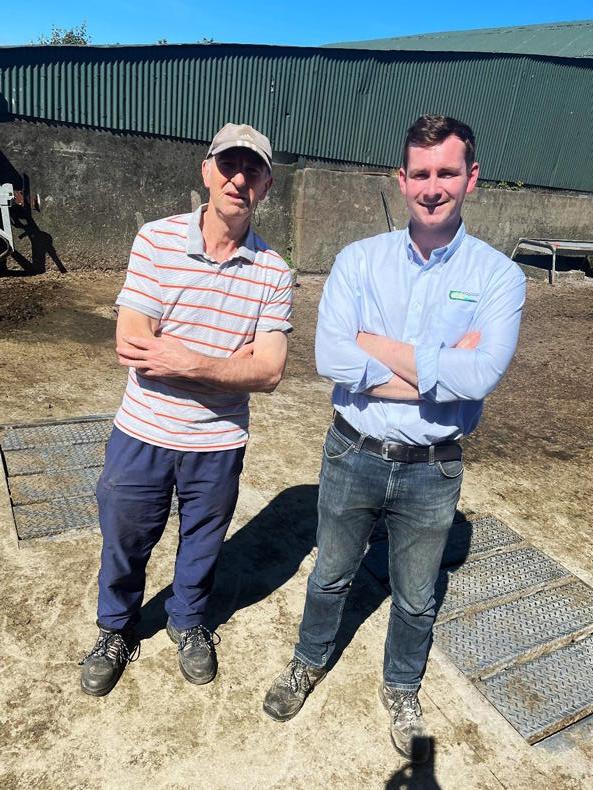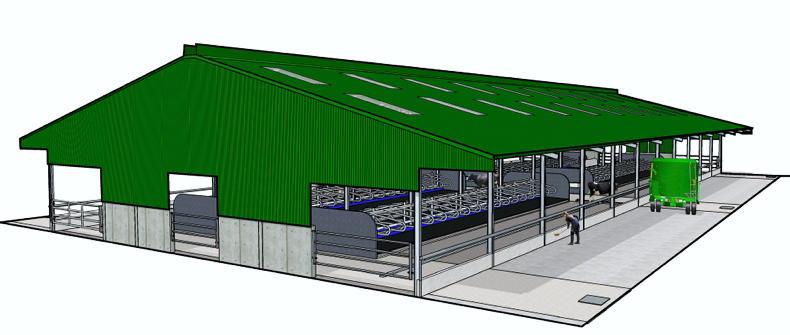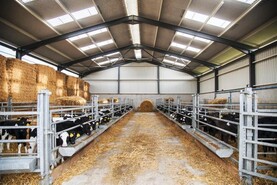There has been a big improvement in the standard of farm buildings over the last thirty years. The biggest change of all is perhaps the additional space we now give to animals.
In Table 1 the space allocation is the space available to the animal, for dairy cows it is the total area of the cubicles and the passageways divided by the number of animals within that space.
The Department of Agriculture, Food and the Marine (DAFM) Specifications of Farm Buildings and the various grant schemes have been a big help in raising standards.

John Cheasty with his small but important cubicle house extension. The additional 1m enables him to make the adjacent cubicles 2.5m in length, the passageway 2.5m wide etc. Yorkshire boarding will be installed above the walls.
Farmers themselves have recognised the importance of space especially the space allocated to passageways within a cubicle house.
The biggest increase in space allocation is in dairy cow cubicle accommodation, this would infer that historically the standard of cubicle housing was particularly poor.
We need to acknowledge that dairy cows do a lot of work in manufacturing milk and much of this work takes place when they are lying down. In fact dairy cows can lie down for up to 14 hours a day, so they need a soft, comfortable and hygienic bed.
Invariably there is a social hierarchy within herds. Cows don’t like rubbing against each other in moving around a cubicle house.
One farmer observed that his cows eat double the amount of silage at an outdoor feed barrier, where the cows have 9m of space than the equivalent length inside where the cows do not have enough room to pass each other (passageway is only about 3m wide).
We should also facilitate their natural herd behaviour as far as possible by having enough feed space so that all animals can eat together. Where there is jostling to get to the feed barrier some cows can suffer from damage to feet, sub optimum body condition or even trauma to a foetus that can lead to abortion.
Features assuming one cow per cubicle
Space/cow (inside feed barrier) 8.3m2.Feed space/cow 0.78m.Slurry storage/cow 7.24m3.Advantages versus and internal centre (single) feed passage
Cost – save €300/cubicle space vs internal feed passage.Cows in one group.Fully slatted floor at crossovers.Disadvantages
Risk of draughts especially if exposed to the prevailing wind.Shed has a larger footprint (2 x 5.2m feed passages versus 1 x 6m) and approximately 18 less cubicles in a 11 bay shed.Can be harder to fit into a yard.Bringing silage a distance.
John Cheasty with his Teagasc adviser John Maguire standing over the settlement tank. This tank is in operation since December 2021 and John is very pleased with it so far. Cows cross the adjacent yard in the summer but in the winter it is almost clean.
The cubicle house in Figure 1 facilitates scraping in both directions, regular scraping has been shown by Teagasc (Burchill et al) to reduce ammonia losses to the environment. A well designed cubicle house will lead to cleaner cows and facilitate a reduction in dry cow antibiotic use.
Achieving excellent performance with old cubicle housing
John Cheasty is milking 105 cows in Fenor Co Waterford. The herd average milk solids (fat and protein) sold in 2022 was 512kg. The average lactations of cows in the herd at 4.8 is in the top 10% of recorded herds (ICBF Calving Report).
This figure reflects the level of management and it also gives some indication of the standard of facilities. John will have a cubicle for each cow for the coming winter and about 0.5m of feeding barrier length per cow after he completes an upgrade of an existing cubicle house.
He places a big emphasis on husbandry – he always condition scores the cows (by handling each one) in November so he can feed them accordingly.

Figure 2: Settlement trap for storm or ‘grey’ water.
In some ways John is a little retro in giving some cows access to an open yard for the additional space, additional feed space around a round feeder and fresh air. There are ventilation issues with an old cubicle house.
John has 25% extra slurry capacity over the minimum required after including the rain on the open yard that the cows have access to as slurry. He may be short of soiled water storage depending on how the new requirements are implemented.
Handling winter runoff from a silage pit and apron
Winter runoff from the silage pit used to enter the slurry tank so two years ago John constructed a two stage settlement tank in the yard to intercept any heavy solids in this runoff. Silage pits should of course be regularly brushed, when open and kept as clean as possible.
The outflow from the settlement tank discharges onto clay (rough ground), it is planned to plant some willow in this area to take up any remaining nutrients in the runoff but grass could be equally as good.
Most farmyards discharge into drains or dykes and it is difficult to recover sediment from these areas. ‘Soakpits’ invariably become clogged up over time.
It should not be necessary to provide access for agitation to each chamber (although John has provided this) – the contents can be sucked up and allowed back in to agitate.
The chambers will need however, regular emptying to ensure dense material that is hard to handle doesn’t build up. Some of the early underpasses had very small tanks and it was an ordeal to empty them using a mini digger or a shovel!
A weir type overflow wall could be used instead of the ‘H’ pipe between the two chambers. The outflow pipe could have two pipes leading into one pipe to reduce the risk of blockage. Preventing excessive leaves and other debris from entering the chambers would also be in order.
The cost of this settlement trap was approximately €4,700. This is considerably more than the TAMS reference cost due to the scale and associated plumbing.
Given that these settlement traps or tanks are not covered by current regulatory requirements, they maybe eligible for grant aid through the recently announced EIP on water quality which will be administerd by LAWPRO, the Local Authority Water Programme.
DAFM Specification S129 is also worth consulting especially for large farmyards which may need a bigger system. It outlines details of settlement tanks for soiled water.
There has been a big improvement in the standard of farm buildings over the last thirty years. The biggest change of all is perhaps the additional space we now give to animals.
In Table 1 the space allocation is the space available to the animal, for dairy cows it is the total area of the cubicles and the passageways divided by the number of animals within that space.
The Department of Agriculture, Food and the Marine (DAFM) Specifications of Farm Buildings and the various grant schemes have been a big help in raising standards.

John Cheasty with his small but important cubicle house extension. The additional 1m enables him to make the adjacent cubicles 2.5m in length, the passageway 2.5m wide etc. Yorkshire boarding will be installed above the walls.
Farmers themselves have recognised the importance of space especially the space allocated to passageways within a cubicle house.
The biggest increase in space allocation is in dairy cow cubicle accommodation, this would infer that historically the standard of cubicle housing was particularly poor.
We need to acknowledge that dairy cows do a lot of work in manufacturing milk and much of this work takes place when they are lying down. In fact dairy cows can lie down for up to 14 hours a day, so they need a soft, comfortable and hygienic bed.
Invariably there is a social hierarchy within herds. Cows don’t like rubbing against each other in moving around a cubicle house.
One farmer observed that his cows eat double the amount of silage at an outdoor feed barrier, where the cows have 9m of space than the equivalent length inside where the cows do not have enough room to pass each other (passageway is only about 3m wide).
We should also facilitate their natural herd behaviour as far as possible by having enough feed space so that all animals can eat together. Where there is jostling to get to the feed barrier some cows can suffer from damage to feet, sub optimum body condition or even trauma to a foetus that can lead to abortion.
Features assuming one cow per cubicle
Space/cow (inside feed barrier) 8.3m2.Feed space/cow 0.78m.Slurry storage/cow 7.24m3.Advantages versus and internal centre (single) feed passage
Cost – save €300/cubicle space vs internal feed passage.Cows in one group.Fully slatted floor at crossovers.Disadvantages
Risk of draughts especially if exposed to the prevailing wind.Shed has a larger footprint (2 x 5.2m feed passages versus 1 x 6m) and approximately 18 less cubicles in a 11 bay shed.Can be harder to fit into a yard.Bringing silage a distance.
John Cheasty with his Teagasc adviser John Maguire standing over the settlement tank. This tank is in operation since December 2021 and John is very pleased with it so far. Cows cross the adjacent yard in the summer but in the winter it is almost clean.
The cubicle house in Figure 1 facilitates scraping in both directions, regular scraping has been shown by Teagasc (Burchill et al) to reduce ammonia losses to the environment. A well designed cubicle house will lead to cleaner cows and facilitate a reduction in dry cow antibiotic use.
Achieving excellent performance with old cubicle housing
John Cheasty is milking 105 cows in Fenor Co Waterford. The herd average milk solids (fat and protein) sold in 2022 was 512kg. The average lactations of cows in the herd at 4.8 is in the top 10% of recorded herds (ICBF Calving Report).
This figure reflects the level of management and it also gives some indication of the standard of facilities. John will have a cubicle for each cow for the coming winter and about 0.5m of feeding barrier length per cow after he completes an upgrade of an existing cubicle house.
He places a big emphasis on husbandry – he always condition scores the cows (by handling each one) in November so he can feed them accordingly.

Figure 2: Settlement trap for storm or ‘grey’ water.
In some ways John is a little retro in giving some cows access to an open yard for the additional space, additional feed space around a round feeder and fresh air. There are ventilation issues with an old cubicle house.
John has 25% extra slurry capacity over the minimum required after including the rain on the open yard that the cows have access to as slurry. He may be short of soiled water storage depending on how the new requirements are implemented.
Handling winter runoff from a silage pit and apron
Winter runoff from the silage pit used to enter the slurry tank so two years ago John constructed a two stage settlement tank in the yard to intercept any heavy solids in this runoff. Silage pits should of course be regularly brushed, when open and kept as clean as possible.
The outflow from the settlement tank discharges onto clay (rough ground), it is planned to plant some willow in this area to take up any remaining nutrients in the runoff but grass could be equally as good.
Most farmyards discharge into drains or dykes and it is difficult to recover sediment from these areas. ‘Soakpits’ invariably become clogged up over time.
It should not be necessary to provide access for agitation to each chamber (although John has provided this) – the contents can be sucked up and allowed back in to agitate.
The chambers will need however, regular emptying to ensure dense material that is hard to handle doesn’t build up. Some of the early underpasses had very small tanks and it was an ordeal to empty them using a mini digger or a shovel!
A weir type overflow wall could be used instead of the ‘H’ pipe between the two chambers. The outflow pipe could have two pipes leading into one pipe to reduce the risk of blockage. Preventing excessive leaves and other debris from entering the chambers would also be in order.
The cost of this settlement trap was approximately €4,700. This is considerably more than the TAMS reference cost due to the scale and associated plumbing.
Given that these settlement traps or tanks are not covered by current regulatory requirements, they maybe eligible for grant aid through the recently announced EIP on water quality which will be administerd by LAWPRO, the Local Authority Water Programme.
DAFM Specification S129 is also worth consulting especially for large farmyards which may need a bigger system. It outlines details of settlement tanks for soiled water.









 This is a subscriber-only article
This is a subscriber-only article










SHARING OPTIONS: